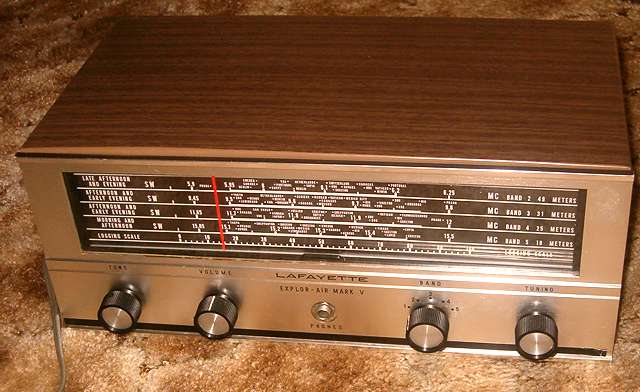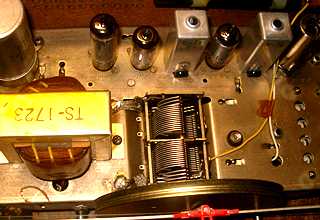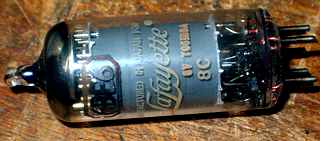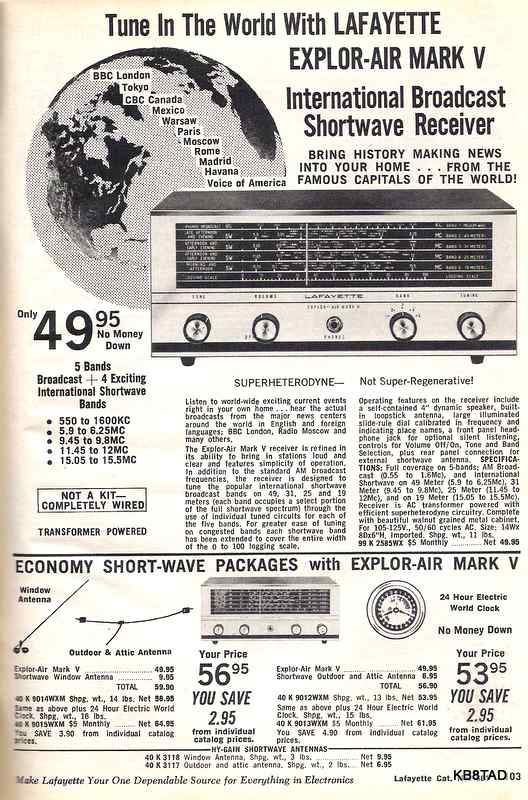


Lafayette Explor-Air Mark V Receiver
Sold by Lafayette in the late 1960s, the Lafayette Explor-Air Mark V is a transformer-operated, single-conversion superhet receiver covering the AM broadcast band and four international shortwave band segments. Those are the 49 meter band (from 5.9 to 6.25 MHz), the 31 meter band (from 9.45 to 9.8 MHz), the 25 meter band (from 11.45 to 12 MHz, and the 19 meter band (from 15.05 to 15.5 MHz.) The tubes are conventional with a 6BE6 converter, 6BA6 IF amplifier, 6AV6 detector and stage of audio, and 6AQ5 for audio output. Its price was $49.95 in the Lafayette Christmas 1967 catalog. The Lafayette catalog part number is 99K25850W.
In band coverage and form factor, it is very similar to the Hallicrafters S-200, with the Explor-Air Mark V using a power transformer.



It is NOT solid-state
Fred Osterman in his book, Shortwave Receivers Past and Present lists this radio as "solid state". I have included a picture of the interior and a closeup of one of its tubes to disprove that error. All four tubes in this set are original "made for Lafayette" in Japan where the radio was also made. Osterman lists the radio as "scarce" which is probably true. This one is the first I had seen. I bought it at a hamfest (amateur radio swap meet) and looked it up in Osterman's book. Had not yet opened the radio and was disappointed to find out from Osterman that it was "solid state" as my preference is for tube radios. I put it on the shelf for a month or so before opening it up for repair and was pleasantly surprised at the true nature of the set.
I had originally noted that the Mark V was introduced in 1970, per the information also found in Osterman's book. His dates are also wrong for this radio. Mike K3BRJ alerted me that his Mark V was clearly marked with the year 1967. That prompted me to check. Here is an ad from the Lafayete Christmas season 1967 catalog (catalog 681).

Repair notes:
The tuning dial did not move. Opening the set revealed that the dial cord was missing. An attempt had been made to work with a piece of string which was loose on the pulley. I figured out how the dial string should be run and replaced it with a length of "Spider-Wire" 65 pound fishing line purchased at Walmart, using bits of masking tape to hold it in place until it was secured on the spring and the pulley. The dial cord worked well and, as it turned out, so did the radio once it was aligned. No further repairs were needed.
The tuning cap on this set uses two sets of plates, one set for the broadcast band and a separate set of just a few plates for the shortwave spread bands. The tuning cap is like those found in AM-FM sets. I'm guessing that the manufacturer simply used an off-the-shelf AM-FM tuning cap to make this unique radio. No bandspread is needed on the shortwave world bands that are laid out much like the bands on the Zenith Transoceanics. The alignment was off considerably on the small spread bands. I am assuming that aging of the ferrite cores may have caused a bit of that. I did not have a schematic, but the alignment adjustments were relatively easy to locate. The oscillator settings for the shortwave bands are all at IF below the frequencies of the spread bands while the broadcast band is above. A frequency counter is very useful in checking the accuracy of the oscillator settings. Once it was aligned, I was not disappointed by the receiver's performance. It performed quite well for a receiver without a TRF stage. The wide spacing of the narrow shortwave bands makes tuning easy and fun. An excellent first shortwave receiver.
10-04; update 5-10
I obtained the Lafayette Explor-Air Mark V at about the same time as the Zenith Transoceanic 8G005 Receiver which was the previous item on the bench.